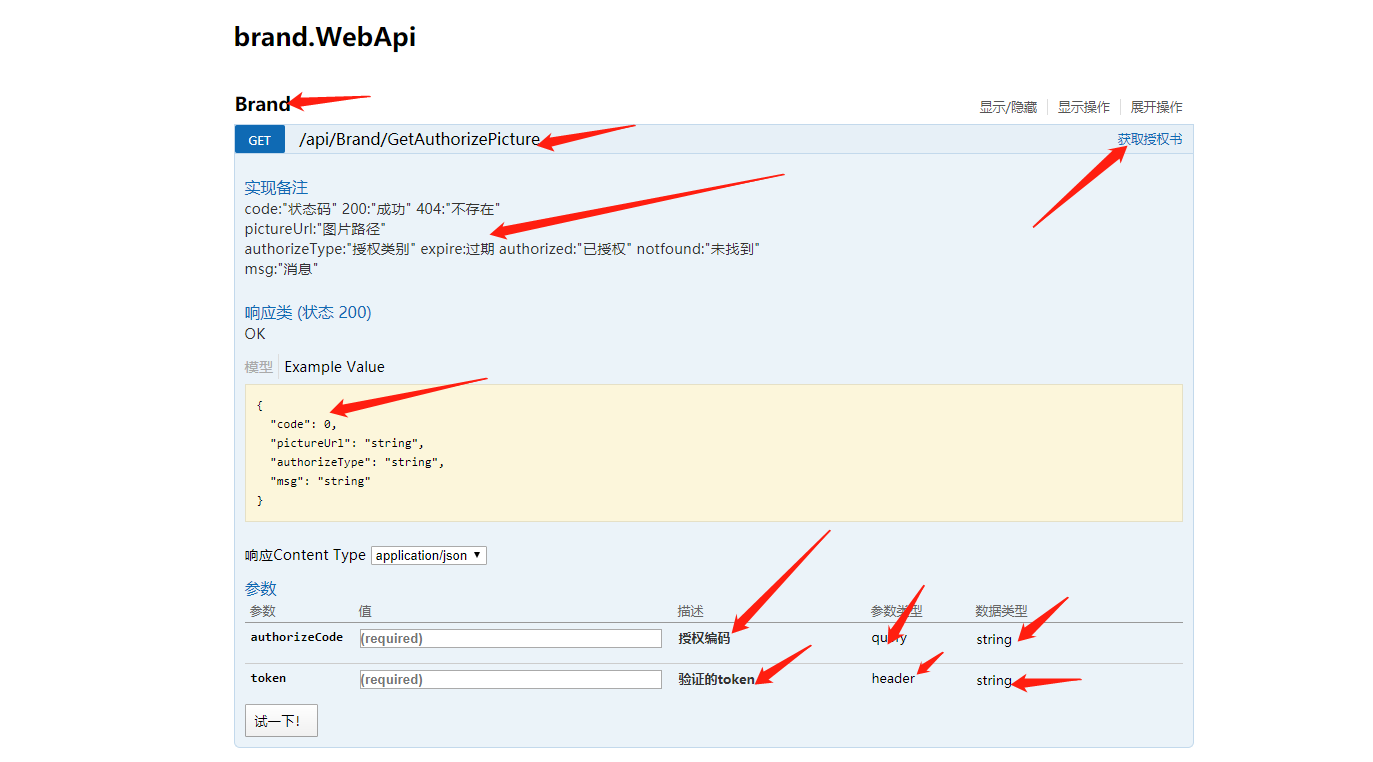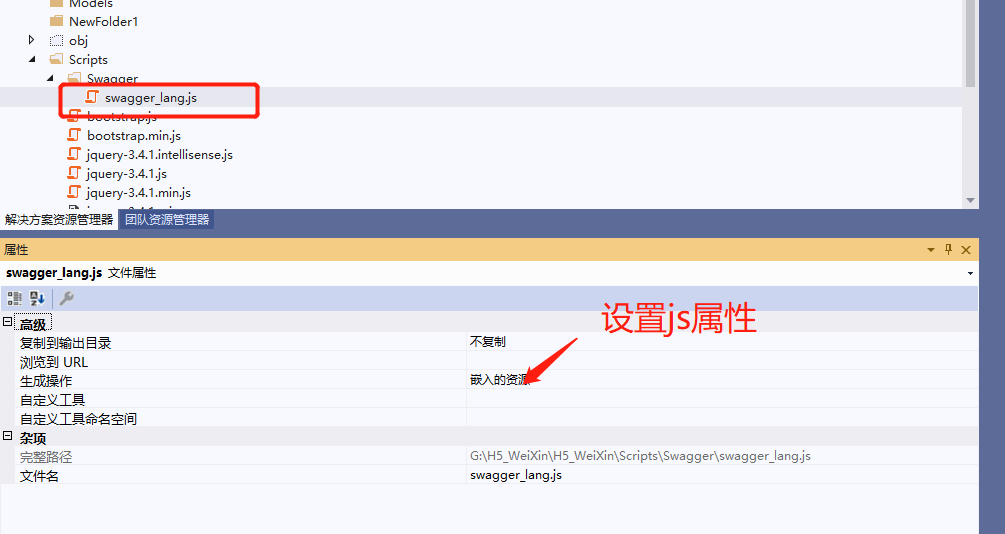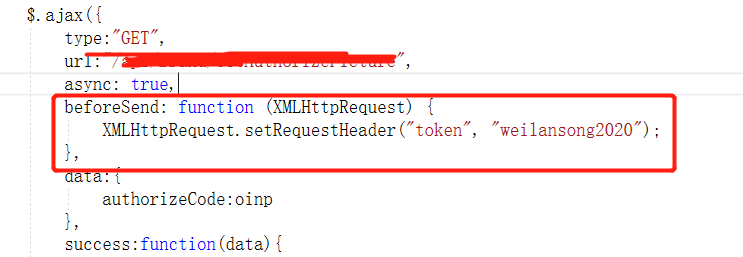1 安装包

设置 注释文档生成路径:

与这个保持一致
controller:
using Domain.Service; using Domain.Service.Models; using H5_WeiXin.App_Start; using Microsoft.Ajax.Utilities; using System; using System.Collections.Generic; using System.ComponentModel; using System.Linq; using System.Net; using System.Net.Http; using System.Web.Http; using System.Web.Http.Description; using System.Web.Http.Results; using WLS.Project.DB.DbContext; namespace H5_WeiXin.Controllers { [RoutePrefix("api/Brand")] public class BrandController : ApiController { /// <summary> /// 获取授权书 /// </summary> /// <param name="authorizeCode">授权编码</param> /// <remarks> /// code:"状态码" 200:"成功" 404:"不存在"<br/> /// pictureUrl:"图片路径"<br/> /// authorizeType:"授权类别" expire:过期 authorized:"已授权" notfound:"未找到"<br/> /// msg:"消息" /// </remarks> /// <returns>授权信息</returns> [HttpGet] [Route("GetAuthorizePicture")] [ResponseType(typeof(RetuenEntity))] [WebApiAuthFilterAttribute] //[AllowAnonymous] public JsonResult<RetuenEntity> GetAuthorizePicture(string authorizeCode) { RetuenEntity model = new RetuenEntity(); try { var result = BrandService.Instance().GetAuthorizePicture(authorizeCode); if (result != null) { model.code = 200; model.pictureUrl = result.PicturePath; if (result.AuthorizeEndDate < DateTime.Now.Date) { model.authorizeType = AuthorizeType.expire.ToString(); } else model.authorizeType = AuthorizeType.authorized.ToString(); model.msg = "请求成功!"; } else { model.code = 404; model.authorizeType = AuthorizeType.notFound.ToString(); model.msg = "资源不存在"; } } catch (Exception ex) { model.code = 404; model.msg = ex.Message; } return Json<RetuenEntity>(model); } [Route("Demo/{id}")] [HttpGet] public JsonResult<string> Get(int id) { return Json<string>("11"); } // POST api/values public void Post([FromBody]string value) { } // PUT api/values/5 public void Put(int id, [FromBody]string value) { } // DELETE api/values/5 public void Delete(int id) { } } }

对应上面参数:

权限控制类:
using Swashbuckle.Swagger; using System; using System.Collections.Generic; using System.Linq; using System.Net; using System.Net.Http; using System.Web; using System.Web.Http; using System.Web.Http.Controllers; using System.Web.Http.Description; using System.Web.Http.Results; using System.Web.SessionState; namespace H5_WeiXin.App_Start { public class GlobalHttpHeaderFilter : IOperationFilter { public void Apply(Operation operation, SchemaRegistry schemaRegistry, ApiDescription apiDescription) { if (operation.parameters == null) operation.parameters = new List<Parameter>(); // 对需要验证的接口添加参数 var isNeedLogin = apiDescription.GetControllerAndActionAttributes<WebApiAuthFilterAttribute>().Any(); if (isNeedLogin) { // //operation.parameters.Add(new Parameter { name = "openID", @in = "header", description = "登录成功时返回的openID", required = false, type = "string" }); //operation.parameters.Add(new Parameter { name = "telephone", @in = "header", description = "获取手机号时返回的手机号", required = false, type = "string" }); operation.parameters.Add(new Parameter { name = "token", @in = "header", description = "验证的token", required = true, type = "string" }); } } } public class WebApiAuthFilterAttribute : AuthorizeAttribute { public override void OnAuthorization(HttpActionContext actionContext) { var header = actionContext.Request; var t = HttpContext.Current.Request.Headers["token"]; if (t != "weilansong2020") // 验证token的正确性 { actionContext.Response = actionContext.Request.CreateResponse(HttpStatusCode.Forbidden); // actionContext.Response.Content = new HttpResponseMessage("1112sasa"); HttpContext.Current.Response.Write(new { error = "unauthorized" }); } else { //base.OnAuthorization(actionContext); } } } }
swaggerconfig:
using System.Web.Http; using WebActivatorEx; using H5_WeiXin; using Swashbuckle.Application; using H5_WeiXin.App_Start; [assembly: PreApplicationStartMethod(typeof(SwaggerConfig), "Register")] namespace H5_WeiXin { public class SwaggerConfig { public static void Register() { var thisAssembly = typeof(SwaggerConfig).Assembly; GlobalConfiguration.Configuration .EnableSwagger(c => { // By default, the service root url is inferred from the request used to access the docs. // However, there may be situations (e.g. proxy and load-balanced environments) where this does not // resolve correctly. You can workaround this by providing your own code to determine the root URL. // //c.RootUrl(req => GetRootUrlFromAppConfig()); // If schemes are not explicitly provided in a Swagger 2.0 document, then the scheme used to access // the docs is taken as the default. If your API supports multiple schemes and you want to be explicit // about them, you can use the "Schemes" option as shown below. // //c.Schemes(new[] { "http", "https" }); // Use "SingleApiVersion" to describe a single version API. Swagger 2.0 includes an "Info" object to // hold additional metadata for an API. Version and title are required but you can also provide // additional fields by chaining methods off SingleApiVersion. // c.SingleApiVersion("v1", "brand.WebApi"); // If you want the output Swagger docs to be indented properly, enable the "PrettyPrint" option. // //c.PrettyPrint(); // If your API has multiple versions, use "MultipleApiVersions" instead of "SingleApiVersion". // In this case, you must provide a lambda that tells Swashbuckle which actions should be // included in the docs for a given API version. Like "SingleApiVersion", each call to "Version" // returns an "Info" builder so you can provide additional metadata per API version. // //c.MultipleApiVersions( // (apiDesc, targetApiVersion) => ResolveVersionSupportByRouteConstraint(apiDesc, targetApiVersion), // (vc) => // { // vc.Version("v2", "Swashbuckle Dummy API V2"); // vc.Version("v1", "Swashbuckle Dummy API V1"); // }); // You can use "BasicAuth", "ApiKey" or "OAuth2" options to describe security schemes for the API. // See https://github.com/swagger-api/swagger-spec/blob/master/versions/2.0.md for more details. // NOTE: These only define the schemes and need to be coupled with a corresponding "security" property // at the document or operation level to indicate which schemes are required for an operation. To do this, // you'll need to implement a custom IDocumentFilter and/or IOperationFilter to set these properties // according to your specific authorization implementation // //c.BasicAuth("basic") // .Description("Basic HTTP Authentication"); // // NOTE: You must also configure 'EnableApiKeySupport' below in the SwaggerUI section //c.ApiKey("apiKey") // .Description("API Key Authentication") // .Name("apiKey") // .In("header"); // //c.OAuth2("oauth2") // .Description("OAuth2 Implicit Grant") // .Flow("implicit") // .AuthorizationUrl("http://petstore.swagger.wordnik.com/api/oauth/dialog") // //.TokenUrl("https://tempuri.org/token") // .Scopes(scopes => // { // scopes.Add("read", "Read access to protected resources"); // scopes.Add("write", "Write access to protected resources"); // }); // Set this flag to omit descriptions for any actions decorated with the Obsolete attribute //c.IgnoreObsoleteActions(); // Each operation be assigned one or more tags which are then used by consumers for various reasons. // For example, the swagger-ui groups operations according to the first tag of each operation. // By default, this will be controller name but you can use the "GroupActionsBy" option to // override with any value. // //c.GroupActionsBy(apiDesc => apiDesc.HttpMethod.ToString()); // You can also specify a custom sort order for groups (as defined by "GroupActionsBy") to dictate // the order in which operations are listed. For example, if the default grouping is in place // (controller name) and you specify a descending alphabetic sort order, then actions from a // ProductsController will be listed before those from a CustomersController. This is typically // used to customize the order of groupings in the swagger-ui. // //c.OrderActionGroupsBy(new DescendingAlphabeticComparer()); // If you annotate Controllers and API Types with // Xml comments (http://msdn.microsoft.com/en-us/library/b2s063f7(v=vs.110).aspx), you can incorporate // those comments into the generated docs and UI. You can enable this by providing the path to one or // more Xml comment files. // // xml path c.IncludeXmlComments(string.Format("{0}/App_Data/brand.WebApi.XML", System.AppDomain.CurrentDomain.BaseDirectory)); // Swashbuckle makes a best attempt at generating Swagger compliant JSON schemas for the various types // exposed in your API. However, there may be occasions when more control of the output is needed. // This is supported through the "MapType" and "SchemaFilter" options: // // Use the "MapType" option to override the Schema generation for a specific type. // It should be noted that the resulting Schema will be placed "inline" for any applicable Operations. // While Swagger 2.0 supports inline definitions for "all" Schema types, the swagger-ui tool does not. // It expects "complex" Schemas to be defined separately and referenced. For this reason, you should only // use the "MapType" option when the resulting Schema is a primitive or array type. If you need to alter a // complex Schema, use a Schema filter. // //c.MapType<ProductType>(() => new Schema { type = "integer", format = "int32" }); // If you want to post-modify "complex" Schemas once they've been generated, across the board or for a // specific type, you can wire up one or more Schema filters. // //c.SchemaFilter<ApplySchemaVendorExtensions>(); // In a Swagger 2.0 document, complex types are typically declared globally and referenced by unique // Schema Id. By default, Swashbuckle does NOT use the full type name in Schema Ids. In most cases, this // works well because it prevents the "implementation detail" of type namespaces from leaking into your // Swagger docs and UI. However, if you have multiple types in your API with the same class name, you'll // need to opt out of this behavior to avoid Schema Id conflicts. // //c.UseFullTypeNameInSchemaIds(); // Alternatively, you can provide your own custom strategy for inferring SchemaId's for // describing "complex" types in your API. // //c.SchemaId(t => t.FullName.Contains('`') ? t.FullName.Substring(0, t.FullName.IndexOf('`')) : t.FullName); // Set this flag to omit schema property descriptions for any type properties decorated with the // Obsolete attribute //c.IgnoreObsoleteProperties(); // In accordance with the built in JsonSerializer, Swashbuckle will, by default, describe enums as integers. // You can change the serializer behavior by configuring the StringToEnumConverter globally or for a given // enum type. Swashbuckle will honor this change out-of-the-box. However, if you use a different // approach to serialize enums as strings, you can also force Swashbuckle to describe them as strings. // //c.DescribeAllEnumsAsStrings(); // Similar to Schema filters, Swashbuckle also supports Operation and Document filters: // // Post-modify Operation descriptions once they've been generated by wiring up one or more // Operation filters. // //c.OperationFilter<AddDefaultResponse>(); // // If you've defined an OAuth2 flow as described above, you could use a custom filter // to inspect some attribute on each action and infer which (if any) OAuth2 scopes are required // to execute the operation // c.OperationFilter<GlobalHttpHeaderFilter>(); // Post-modify the entire Swagger document by wiring up one or more Document filters. // This gives full control to modify the final SwaggerDocument. You should have a good understanding of // the Swagger 2.0 spec. - https://github.com/swagger-api/swagger-spec/blob/master/versions/2.0.md // before using this option. // //c.DocumentFilter<ApplyDocumentVendorExtensions>(); // In contrast to WebApi, Swagger 2.0 does not include the query string component when mapping a URL // to an action. As a result, Swashbuckle will raise an exception if it encounters multiple actions // with the same path (sans query string) and HTTP method. You can workaround this by providing a // custom strategy to pick a winner or merge the descriptions for the purposes of the Swagger docs // //c.ResolveConflictingActions(apiDescriptions => apiDescriptions.First()); // Wrap the default SwaggerGenerator with additional behavior (e.g. caching) or provide an // alternative implementation for ISwaggerProvider with the CustomProvider option. // //c.CustomProvider((defaultProvider) => new CachingSwaggerProvider(defaultProvider)); }) .EnableSwaggerUi(c => { // Use the "DocumentTitle" option to change the Document title. // Very helpful when you have multiple Swagger pages open, to tell them apart. // //c.DocumentTitle("My Swagger UI"); // Use the "InjectStylesheet" option to enrich the UI with one or more additional CSS stylesheets. // The file must be included in your project as an "Embedded Resource", and then the resource's // "Logical Name" is passed to the method as shown below. // //c.InjectStylesheet(containingAssembly, "Swashbuckle.Dummy.SwaggerExtensions.testStyles1.css"); // Use the "InjectJavaScript" option to invoke one or more custom JavaScripts after the swagger-ui // has loaded. The file must be included in your project as an "Embedded Resource", and then the resource's // "Logical Name" is passed to the method as shown above. // c.InjectJavaScript(thisAssembly, "H5_WeiXin.Scripts.Swagger.swagger_lang.js");// 汉化js // The swagger-ui renders boolean data types as a dropdown. By default, it provides "true" and "false" // strings as the possible choices. You can use this option to change these to something else, // for example 0 and 1. // //c.BooleanValues(new[] { "0", "1" }); // By default, swagger-ui will validate specs against swagger.io's online validator and display the result // in a badge at the bottom of the page. Use these options to set a different validator URL or to disable the // feature entirely. c.SetValidatorUrl("http://localhost/validator"); //c.DisableValidator(); // Use this option to control how the Operation listing is displayed. // It can be set to "None" (default), "List" (shows operations for each resource), // or "Full" (fully expanded: shows operations and their details). // //c.DocExpansion(DocExpansion.List); // Specify which HTTP operations will have the 'Try it out!' option. An empty paramter list disables // it for all operations. // //c.SupportedSubmitMethods("GET", "HEAD"); // Use the CustomAsset option to provide your own version of assets used in the swagger-ui. // It's typically used to instruct Swashbuckle to return your version instead of the default // when a request is made for "index.html". As with all custom content, the file must be included // in your project as an "Embedded Resource", and then the resource's "Logical Name" is passed to // the method as shown below. // //c.CustomAsset("index", containingAssembly, "YourWebApiProject.SwaggerExtensions.index.html"); // If your API has multiple versions and you've applied the MultipleApiVersions setting // as described above, you can also enable a select box in the swagger-ui, that displays // a discovery URL for each version. This provides a convenient way for users to browse documentation // for different API versions. //c.EnableDiscoveryUrlSelector(); // If your API supports the OAuth2 Implicit flow, and you've described it correctly, according to // the Swagger 2.0 specification, you can enable UI support as shown below. // //c.EnableOAuth2Support( // clientId: "test-client-id", // clientSecret: null, // realm: "test-realm", // appName: "Swagger UI" // //additionalQueryStringParams: new Dictionary<string, string>() { { "foo", "bar" } } //); // If your API supports ApiKey, you can override the default values. // "apiKeyIn" can either be "query" or "header" // c.EnableApiKeySupport("authorize", "header"); c.DocumentTitle("品牌授权接口"); ; }); } } }
汉化配置:
新建文件夹及文件,复制一下js
/// <summary> /// 中文转换 /// </summary> var SwaggerTranslator = (function () { //定时执行检测是否转换成中文,最多执行500次 即500*50/1000=25s var iexcute = 0, //中文语言包 _words = { "Warning: Deprecated": "警告:已过时", "Implementation Notes": "实现备注", "Response Class": "响应类", "Status": "状态", "Parameters": "参数", "Parameter": "参数", "Value": "值", "Description": "描述", "Parameter Type": "参数类型", "Data Type": "数据类型", "Response Messages": "响应消息", "HTTP Status Code": "HTTP状态码", "Reason": "原因", "Response Model": "响应模型", "Request URL": "请求URL", "Response Body": "响应体", "Response Code": "响应码", "Response Headers": "响应头", "Hide Response": "隐藏响应", "Headers": "头", "Try it out!": "试一下!", "Show/Hide": "显示/隐藏", "List Operations": "显示操作", "Expand Operations": "展开操作", "Raw": "原始", "can't parse JSON. Raw result": "无法解析JSON. 原始结果", "Model Schema": "模型架构", "Model": "模型", "apply": "应用", "Username": "用户名", "Password": "密码", "Terms of service": "服务条款", "Created by": "创建者", "See more at": "查看更多:", "Contact the developer": "联系开发者", "api version": "api版本", "Response Content Type": "响应Content Type", "fetching resource": "正在获取资源", "fetching resource list": "正在获取资源列表", "Explore": "浏览", "Show Swagger Petstore Example Apis": "显示 Swagger Petstore 示例 Apis", "Can't read from server. It may not have the appropriate access-control-origin settings.": "无法从服务器读取。可能没有正确设置access-control-origin。", "Please specify the protocol for": "请指定协议:", "Can't read swagger JSON from": "无法读取swagger JSON于", "Finished Loading Resource Information. Rendering Swagger UI": "已加载资源信息。正在渲染Swagger UI", "Unable to read api": "无法读取api", "from path": "从路径", "Click to set as parameter value": "点击设置参数", "server returned": "服务器返回" }, //定时执行转换 _translator2Cn = function () { if ($("#resources_container .resource").length > 0) { _tryTranslate(); } if ($("#explore").text() == "Explore" && iexcute < 500) { iexcute++; setTimeout(_translator2Cn, 50); } }, //设置控制器注释 _setControllerSummary = function () { $.ajax({ type: "get", async: true, url: $("#input_baseUrl").val(), dataType: "json", success: function (data) { var summaryDict = data.ControllerDesc; var id, controllerName, strSummary; $("#resources_container .resource").each(function (i, item) { id = $(item).attr("id"); if (id) { controllerName = id.substring(9); strSummary = summaryDict[controllerName]; if (strSummary) { $(item).children(".heading").children(".options").prepend('<li class="controller-summary" title="' + strSummary + '">' + strSummary + '</li>'); } } }); } }); }, //尝试将英文转换成中文 _tryTranslate = function () { $('[data-sw-translate]').each(function () { $(this).html(_getLangDesc($(this).html())); $(this).val(_getLangDesc($(this).val())); $(this).attr('title', _getLangDesc($(this).attr('title'))); }); }, _getLangDesc = function (word) { return _words[$.trim(word)] !== undefined ? _words[$.trim(word)] : word; }; return { Translator: function () { document.title = "API描述文档"; $('body').append('<style type="text/css">.controller-summary{color:#10a54a !important;word-break:keep-all;white-space:nowrap;overflow:hidden;text-overflow:ellipsis;max-250px;text-align:right;cursor:default;} </style>'); $("#logo").html("接口描述").attr("href", "/Home/Index"); //设置控制器描述 _setControllerSummary(); _translator2Cn(); } } })(); //执行转换 SwaggerTranslator.Translator();

ajax 请求 可添加头部:
